| Page 1 | . . . . . . | Prolog |
| The monitors exteriors | ||
| Page 2 | . . . . . . | The monitors interiors |
| Page 3 | . . . . . . | Beam landing adjustments |
| Page 4 | . . . . . . | Adjusting convergence |
| Page 5 | . . . . . . | Setting up a channel |
| Page 6 | . . . . . . | Comparison 1 - Alundra |
| Page 7 | . . . . . . | Comparison 2 - Legend of Oasis |
| Page 8 | . . . . . . | Comparison 3 - Seiken Densetsu 3 |
| Page 9 | . . . . . . | Comparison 4 - Keio Flying Squadron 2 |
| Page 10 | . . . . . . | Comparison 5 - Mawaru Penguindrum |
| Page 11 | . . . . . . | Comparison 6 - Naked Lunch |
| Page 12 | . . . . . . | Comparison 7 - Castaway on the Moon |
| Page 13 | . . . . . . | Comparing resolutions |
| Page 14 | . . . . . . | The BVM and the Extron RGB interface |
| Page 15 | . . . . . . | The HDSDI card |
| Page 16 | . . . . . . | The 720p problem |
| VCR Mode | ||
| Page 17 | . . . . . . | Emulated scanlines versus the real thing |
| Page 18 | . . . . . . | Brightness |
| Sensivity to light | ||
| The defocus problem | ||
| Page 19 | . . . . . . | Conclusion |
Note: It's 2017 and I'm reviewing here a monitor that was made in 2003. The tube of the monitor was replaced in 2008. The monitor has an operation time of over 43000 hours. If the operation time was not reset when the tube was replaced, then the current tube should have about 20000 hours on it. In short: it's everything but new.
To start things off, why did I buy this monitor?
I have liked the CRT technology for a long time. I have refused to buy a modern flatscreen TV or monitor for many years. Longer than most people at least. In 2013 I finally gave in and bought a 42 inch LED/LCD TV. More and more movies were available in beautiful high definition which I wanted to experience. I knew how bad these TVs were for older games. I kept my CRT around, I knew I would use it again one day.
At the beginning of 2016 I felt this longing to play some old games again. I was looking for ways to best play them on the LCD TV. I found out that the Super Nintendo emulator Snes9x had this TV mode filter which made the output look very similar to that of a CRT TV. I liked that and played like that for a while. I found a similar looking filter for the Mega Drive emulator Fusion. I also wanted to play NES games with such a filter. I tried every NES emulator I could find, none of them had such a filter.
I searched around and came upon this thing called "Retroarch", it doesn't have a TV mode filter, it has shaders and people have made CRT shaders for it. What's more, this thing doesn't just emulate a single console, it emulates all kinds of systems. You can use shaders for every system it supports. And you can control everything through a gamepad. Wow. Why had I not heard of this before? This was very similar to discovering iRacing. Why are these amazing things not more well known?
During my search for an NES emulator with a TV mode filter, I also come upon these Youtube videos that talked about how to best play old consoles. They mentioned RGB monitors and used the terms "PVM" and "BVM". PVM? BVM? Hmmm...
I used Retroarch a lot the next weeks. After some time I had the idea to take the old CRT TV out again. I wanted to see how close these shaders come to the real thing. What can I say? Those shaders are nice if you don't have any other options. But the real thing beats it easily. It looks so much more vibrant and sharp. Also, it has no lag. The LCD TV has about two frames of lag and Retroarch itself also adds a bit of lag.
My interest in Retroarch disappeared. I began to use my CRT TV again. I don't have room for an extra gaming corner. I had to swap the TVs each time I wanted to play. On the weekends I had time to play games, so I put the LCD TV aside and put up the CRT TV. That was my routine for some time.
As you can imagine, I don't spend the whole weekend playing games. During the evenings I might want to watch a movie. I don't want to constantly lug these TVs around. That 28 inch CRT weighs 35kg. Very lightweight for its size, but still. I had to find a way to watch movies on the CRT TV.
Back in the day when this was my only TV, I had a graphic card in my PC with S-Video out. I used that for watching downloaded movies. I still have that card around, but I didn't want to install it just for that. Even back then, I always wanted to use something better than S-Video.
When I bought the LCD TV I also bought a Playstation 3. I remembered the PS3 outputs a very good looking RGB image through SCART. And the PS3 has support for Media Servers. The PS3 plus Universal Media Server got me what I wanted. I could watch every video file from my PC on the TV in 576i through RGB. That looks a lot better than 640x480 through S-Video what I used before.
Watching movies on it made me fall in love again with that CRT look.
During all this time I learned more and more about these PVMs and BVMs. I watched more videos and read forum posts. So those are professional video monitors from Sony and BVMs are supperior to PVMs. And look, there is this video about a 24 inch BVM that supports all kinds of resolutions. You can play games in 240p on it and it also does high definition. And BVMs are said to be the best CRTs ever made? Ho, ho, ho...
This could be something for me. I could play games on it and I could watch movies in HD. I would no longer need to swap TVs. And from what I saw, it had such a beautiful picture. There even exists a 32 inch version of this BVM? But wait, the 32 inch version weighs 94 kg and is 70 cm deep? Uhhh... ooookayyyy...
Weeks passed. The BVM stayed in my mind. And I eventually decided to try to buy one. I was willing to pay good money for it and willing to deal with the weight and size. I wanted one pretty bad. You could say I became obsessed with it even.
Well, I don't know if this is interesting to read. I could now tell you how I got one. But maybe it is better to skip forward a bit. 3 months after I made the decision, I had what I wanted, a Sony BVM D32.
Let's take a look:
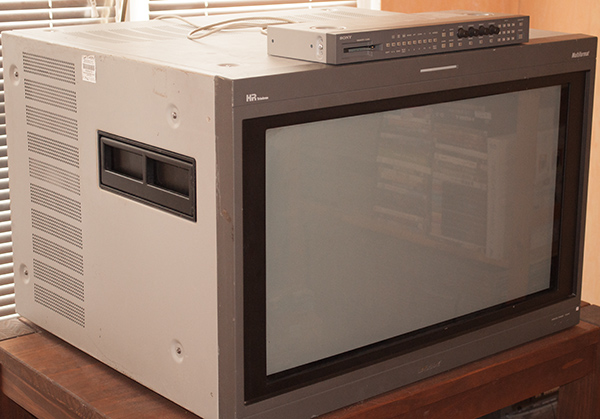
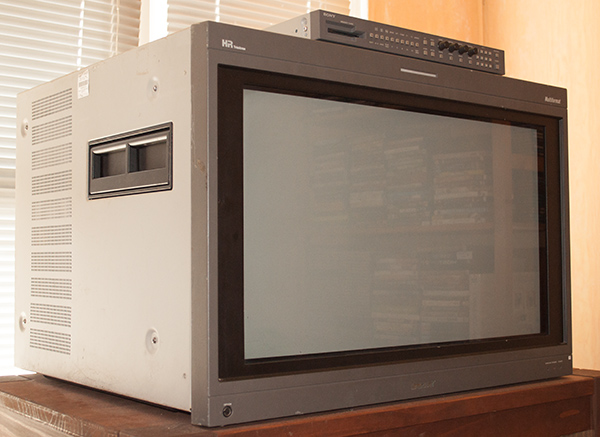
That's what this monitor looks like. From the front I think it looks quite good. From the side not so much. When you see one of these in person for the first time, it's quite shocking how big that box is. Of course I'm used to it by now.
The case has a lot of scratches and the Sony logo is missing, but the screen itself is in flawless condition.
The monitor itself has no buttons whatsoever. You can not even turn it on without a control unit. There are two types of control units, the one pictured, a BKM 10-R, and a smaller handheld version, the BKM 11-R. Both use cables. I don't think there are any true remote controls for these monitors.
The whole case is made of metal. It is only the four legs that are made of plastic:
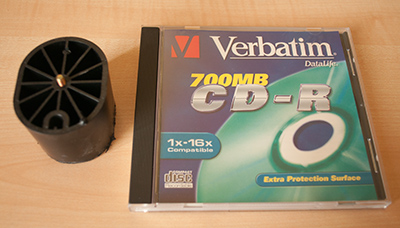
I only have that one leg (the CD is for size comparison). The technician who sold me the monitor does not know the history behind it, he was not responsible for this particular monitor.
On both sides you have these handles:
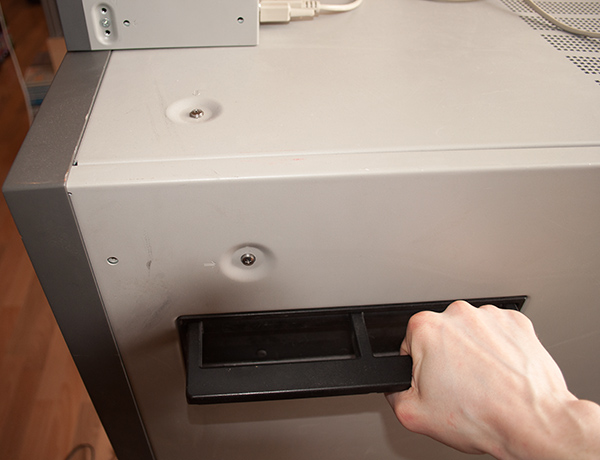
As you can see, they are big enough to grab them with two hands. Absolutely needed to move this thing.
I live on the fifth floor and there is no elevator in the building. We had to carry it up the stairs. There are people who claim you need 4 people, but you can definitely do it with 2. You don't need to be a body builder either, a decent fitness is enough.
This monitor is modular like a PC, you can remove a lot of the parts very easily. I did that before we started to carry it up the stairs. It really helped. The weight came down a few kilos, I'm sure I got it below 90 kgs.
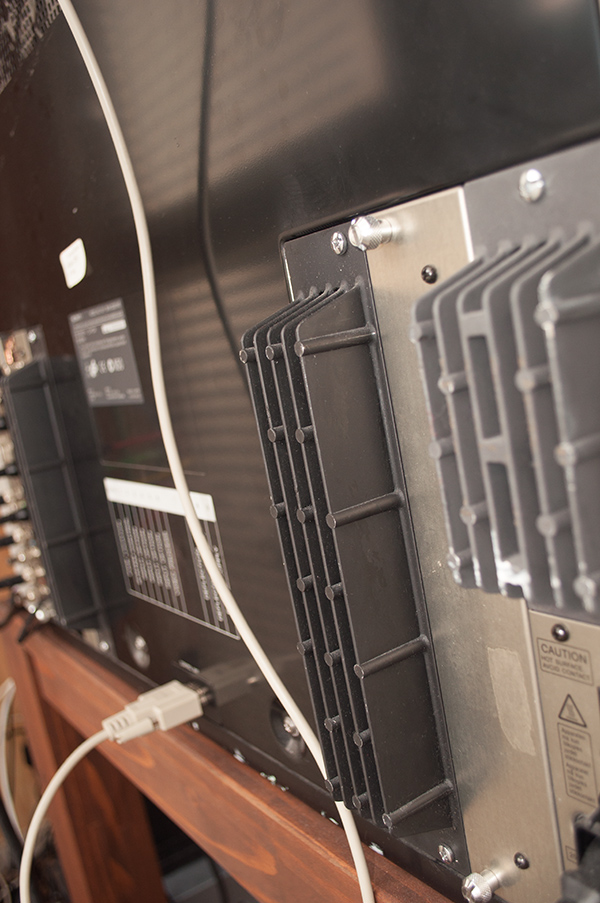
That is a look at the back of the monitor. At the right you can see the power supply, besides that is the white uniformity board and besides that is the deflection board. These can all be removed easily. If you want to remove the deflection board you need to unplug a cable first.
When I saw photos from these monitors I always thought that slot between the deflection board and the power supply was empty. No, there is something behind it.
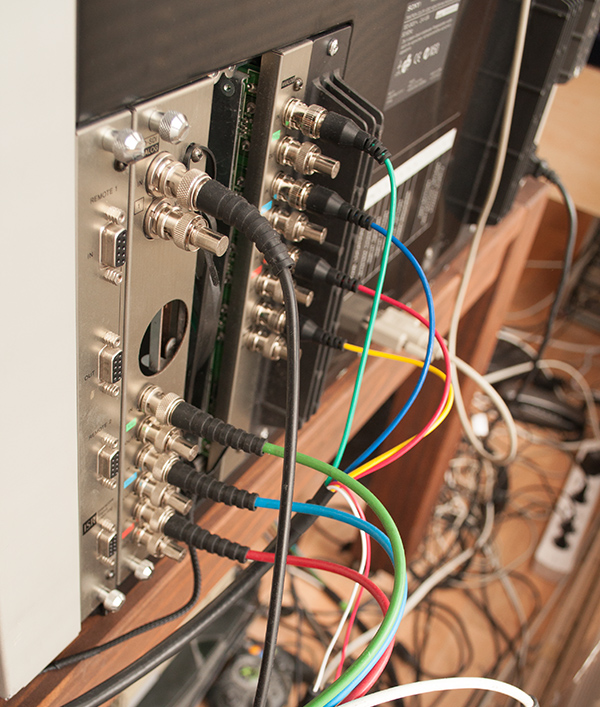
And that is the other side. On the left is the system control board. Then comes the HD SDI board, I use it for HD SDI and analog RGB sync on green. Then two empty slots. And then the standard input board / video processor, I use that to connect devices that output RGB through SCART.
That standard input board and that heat sink alongside it are actually one board. Before I got the monitor I thought that thing with the inputs is one board and that thing with the heat sink is the video processor. I was wrong here too. There is nothing behind the heat sink, just heat pipes going to the board itself.
As you can see, it does not have any connectors you might be familiar with from consumer TVs. There are only BNC connectors. Modern OLED BVMs at least have HDMI. But with this thing there is nothing you can directly connect to it. The easiest way to connect something are Cinch to BNC adapters:
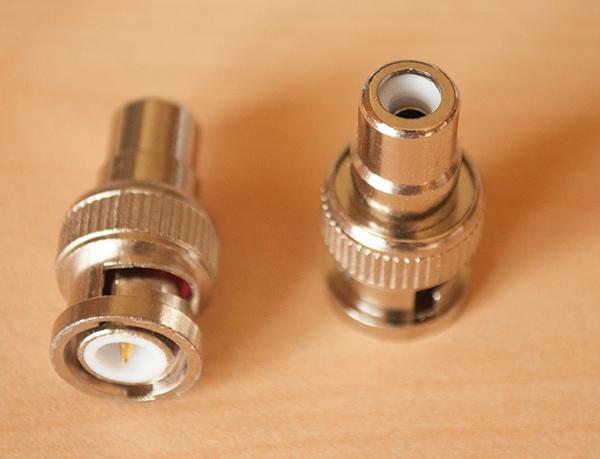
Take 3 of these and you can connect devices that output component video.
SCART is also relatively easy, you need something like this:
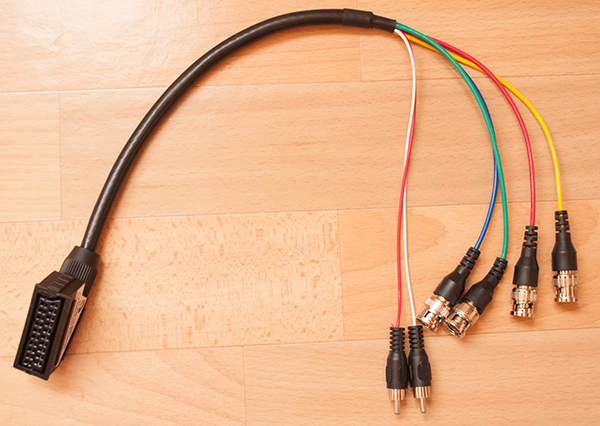
There are SCART adapters with a build in "sync stripper", you don't need that with this monitor.
All of the input boards have loop through outputs for every input. If you are not using the outputs, you need to terminate the outputs with a 75 Ohm terminator. At least the analog outputs. I have also terminated the digital output, but I don't think it is needed.
If you search the web, you will find more photos of what these monitors look like from the outside. But what you will rarely find is what it looks like inside...